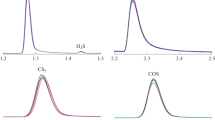Summary
The separation efficiency of capillary columns (about) 100000 effective theoretical plates for a 100 m, 0,25 mm i.d.-column) is sufficient for the separation of deuterium labelled compounds from the corresponding unlabelled compounds. By means of the mentioned column d2-labelled hydrocarbons can be separated completely from undeuterated molecules without difficulties.
The mentioned separation efficiency is not sufficient for the investigation of the influence of the positions of the deuterium atoms or the complete separation of12C/13C- or10B/11B-systems. By application of an “isotope-scan”-method the profiles of overlapped peaks obtained from incomplete separations of isotopic molecules can be recognized. This can only be done using a capillary gas chromatography-mass spectrometer-combination because of the very small influence of isotopic effects on the retention data. By this method orders of elution of molecules containing the different isotopes mentioned could be determined.
Zusammenfassung
Die Trennleistung von Kapillaren ermöglicht die gas-chromatographische Trennung Deuterium-markierter Moleküle von unmarkierten. So können z.B. D2-markierte von deuteriumfreien mit etwa 100000 effektiven theoretischen Böden einer 100 m langen Kapillare 0,25 mm i.ø, vollständig getrennt werden.
Nicht ausreichend ist diese Trennleistung für die Untersuchung von Einflüssen der Position der Deuteriumatome auf das Retentions-verhalten oder von10B/11B- bzw.12C/13C-Trennungen. In einer Kopplung von Kapillar-Gas-Chromatographie und Massenspektrometrie mit voller Trennleistung ist es mit Hilfe einer “Isotopenscan”-Methode möglich, die Profile überlagerter Peaks, die durch partielle Trennung von Peaks mit verschiedenen Isotopen entstehen, sichtbar zu machen.
Sommaire
L'efficacité des colonnes capillaires utilisées en chromatographie en phase gazeuse permet de séparer des molécules au deutérium marquées des molécules non marquées. Ainsi il est possible de séparer completement des molécules d2-marquées de molécules exemptes de deutérium au moyen des 100000 plateaux théoriques effectifs d'une colonne capillaire de 100 m de longueur.
Mais cette efficacité ne suffit ni pour étudier l'influence de la position des atomes de deutérium sur la rétention ni pour étudier les séparations10B/11B ou12C/13C. Par la combinaison de la chromatographie en phase gazeuse et de la spectrometrie de masse il devient possible au moyen d'une méthode de balayage isotopique de rendre visible les profils de pics interférants qui proviennent d'une séparation partielle des pics des molécules contenant des isotopes différents.
Similar content being viewed by others
Literaturverzeichnis
G. Schomburg, J. Chromatogr.14, 157 (1964)
G. Schomburg, J. Chromatogr.23, 1 (1966)
G. Schomburg, J. Chromatogr.23, 18 (1966)
G. Schomburg, Separation Science1 (2 und 3), 339 (1966)
G. Schomburg, Analyt. Chim. Acta38, 45 (1967)
G. Schomburg undD. Henneberg, Z. anal. Chem., im Druck
M. Mohnke undW. Saffert, in M. van Swaay (Editor), Gas Chromatogr. 1962, Butterworths, London 1962
W. E. Falconer undR. J. Cvetanovic, Anal. Chem.34, 1064 (1962)
A. Liberti, G.P. Cartoni undF. Bruner, Gas Chromatogr. Brighton 1964, ed. A. Goldup, Butterworths London 1965, S. 301
F. Bruner, G. P. Cartoni, J. Chromatogr.10, 284 (1963)
A. Liberti, G. P. Cartoni undF. Bruner, J. Chromatogr.12, 8 (1964)
T. Gäumann, Diskussionsbemerkung J. Chromatogr. Symposium Brighton 1964, S. 311, Inst. of Petroleum
G. P. Cartoni, Diskussionsbemerkung Gas Chromatogr. Symposium Brighton 1964, S. 311, Inst. of Petroleum
D. Henneberg undG. Schomburg, Intern. Mass Spectrometry Conference Berlin 1967, preprint
M. C. Simmons, D. B. Richardson undC. R. Durett, Gas Chromatogr. Edinburgh 1960, ed. R.P.W. Scott, London 1960, S. 211, Butterworths
T. Dvoretzky, D. B. Richardson undC. R. Durett, Anal. Chem.35, 545 (1963)
D. Henneberg undG. Schomburg, Gas Chromatogr. Hamburg 1962, ed. van Swaay, Butterworths London 1963, S. 191
D. Henneberg undG. Schomburg, Z. anal. Chem. 215, 424 (1965)
D. Joly, Z. anal. Chem., im Druck
R. Kaiser, Chimia21, 235 (1967)
D. Henneberg, Anal. Chem.8, 495 (1966)
C. P. Lindemann undI. L. Annis, Anal. Chem.32, 1742 (1960)
I. A. Dorsey, R. H. Hunt, M. J. O'Neal, Anal. Chem.35, 511 (1963)
C. C. Sweeley, W. A. Elliot, R. Ryhage, Anal. Chem.38, 1549 (1966)
S. Sideman undI. Giladi, Gas Chromatogr. Hamburg 1962, ed. van Swaay, Butterworths London 1962, S. 178
Author information
Authors and Affiliations
Rights and permissions
About this article
Cite this article
Schomburg, G., Henneberg, D. Zum Retentionsverhalten isotopenhaltiger Verbindungen, unter Verwendung einer Isotopen-scan-Methode in einer Kombination Kapillargas-Chromatographie-Massenspektrometrie. Chromatographia 1, 23–31 (1968). https://doi.org/10.1007/BF02259006
Received:
Accepted:
Published:
Issue Date:
DOI: https://doi.org/10.1007/BF02259006



